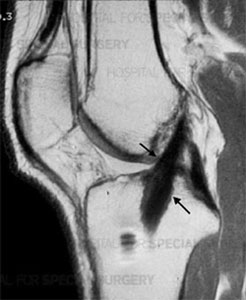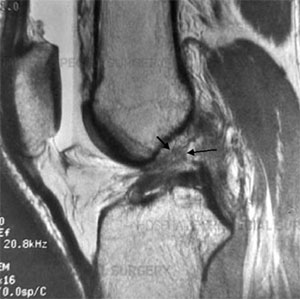Can You Tear Your Acl and Not Know It
Torn ACL
A complex set up of tendons and ligaments help stabilize and back up the knee joint with its every movement, from a simple walking stride to an ice skater'due south spring. Unfortunately, these tissues are vulnerable to injury. In detail, tears of the anterior cruciate ligament (ACL) are quite common amidst athletes and active individuals of all ages.
- What is the ACL?
- What is an ACL tear?
- Who tears their ACL?
- How do you lot tear your ACL?
- Symptoms: What happens when the ACL is torn?
- What should I do if I think I accept torn my ACL?
- How is a torn ACL diagnosed?
- Can ACL tears exist treated nonsurgically?
- When is ACL surgery necessary?
- Articles for further reading
What is the ACL?
The anterior cruciate ligament (ACL) is one of 4 major ligaments in the knee joint. It helps maintain the knee's rotational stability and prevents the tibia (shinbone) from slipping in front of the femur (thighbone).
The ACL is especially vulnerable to injury during athletic action or as the outcome of impact, and a torn ACL is a common injury in athletes of all levels. It is especially common in sports with a lot of leg planting, cutting and pivoting, such as soccer, basketball, skiing and football. Surgery is often required to repair an ACL tear.
What is an ACL tear?
An ACL tear is when the anterior cruciate ligament becomes partially or completely ruptured. One time torn, an ACL cannot regrow or heal on its own.

Side-view MRI showing a healthy, intact ACL

Side-view MRI showing a completely torn ACL
Who tears their ACL?
People of all ages, concrete atmospheric condition and abilities can tear an ACL. Active women experience a college incidence of ACL injuries than men considering their biomechanics tend to put more stress on their knees.
ACL injuries are also common in children, specially as youth sports become increasingly competitive. Until recently, ACL treatment for children and adolescents was exclusively nonsurgical. This was because tradtional ACL surgery techniques could cause growing children to develop a leg length discrepancy or growth deformity. Even so, newer surgical techniques have made surgical repair an selection for many kids and teens.
How do you tear your ACL?
A fractional or complete ACL tear (rupture) often occurs during a sudden twisting movement, in which a person stops quickly and changes direction, especially while pivoting or landing later a jump.
A sudden, high-energy impact to the articulatio genus can also cause the ACL to tear. ACL tear injuries are often accompanied by injuries to other tissues in the knee, including cartilage or boosted knee joint ligaments, such as the MPFL.
Symptoms: What happens when the ACL is torn?
Common symptoms of a torn ACL include:
- popping sound at the time of injury
- hurting
- swelling
- knee joint instability
When a person tears their ACL, they oft report hearing a popping sound at the moment that the tear occurs. The knee will speedily smashing and, in many cases, feel unstable. However, in some less severe tears, these symptoms may be balmy. This is especially the case in people whose lifestyles do not involve intense physical activity.
If the ACL is completely torn, there will be instability in the knee that will cause feelings of sudden shifting or buckling. People will be unable to:
- bound and land on the knee
- accelerate and so modify directions
- rapidly pivot on the knee
What should I do if I call back I have torn my ACL?
Immediately after an ACL injury, it is of import to:
- Stay off the leg and drag it.
- Decrease the inflammation in the knee joint by:
- Applying ice.
- Taking nonsteroidal anti-inflammatory drugs (NSAIDs) such as ibuprofen.
- Consult an orthopedist or sports medicine md equally soon as possible.
The doc volition determine how bad the ACL injury is and review whether nonsurgical handling and rehabilitation volition exist enough or if orthopedic surgery is necessary. Whether or non surgery is performed, concrete therapy will be critical to strengthen the muscles surrounding the knee and improve its range of motion.
How is a torn ACL diagnosed?
A doctor can usually diagnose a torn ACL from a physical exam, although magnetic resonance imaging (MRI) is helpful. Getting an MRI is as well important to find out if other parts of the genu accept been injured.
Can ACL tears be treated nonsurgically?
Surgery is not necessary for all patients. The main conservative treatments are rest and anti-inflammatory medication to reduce pain and inflammation.
Some patients may too exist fitted with a leg brace for use during activities that place stress on the knee joint. The doctor will also prescribe a course of physical therapy. This rehabiliation regimen is extremely important for preventing future injury.
Possible disadvantages of nonsurgical treatments
The long-term effect for patients who are treated nonsurgically varies. Those who return to unrestricted activity are likely to experience some knee instability. Pain may exist associated with the physical therapy regimen. In the absence of an intact ACL – fifty-fifty when no other injury is nowadays – the menisci (pads of cartilage that cushion the bones that meet at the articulatio genus articulation) have a higher risk of injury. If a tear forms in 1 or both menisci of the knee, pain and swelling may occur. More chiefly, a damaged meniscus increases a patient's risk of developing osteoarthritis of the knee afterwards in life.
When is ACL surgery necessary?
The pick to accept surgery is usually based on the patient's lifestyle. In athletes and other people of any historic period who wish to continue doing physically demanding activeness, an ACL reconstruction surgery is often needed.
If the injury is not too severe, some patients who do not need to perform intense athletics or physical labor may exist able to become without surgery and still lead active, healthy lifestyles. Many people with torn ACLs who receive conservative, nonsurgical treatments are able to swim, jog and use virtually equipment found at the gym or health club.
Articles for further reading
Beneath, explore articles and other content on ACL injuries or select Treating Physicians to find the best physician or surgeon at HSS to adapt your specific status and insurance.
Back in the Game patient stories
Weblog posts
In the news
rodriguezconiefor.blogspot.com
Source: https://www.hss.edu/condition-list_torn-acl.asp
0 Response to "Can You Tear Your Acl and Not Know It"
Post a Comment